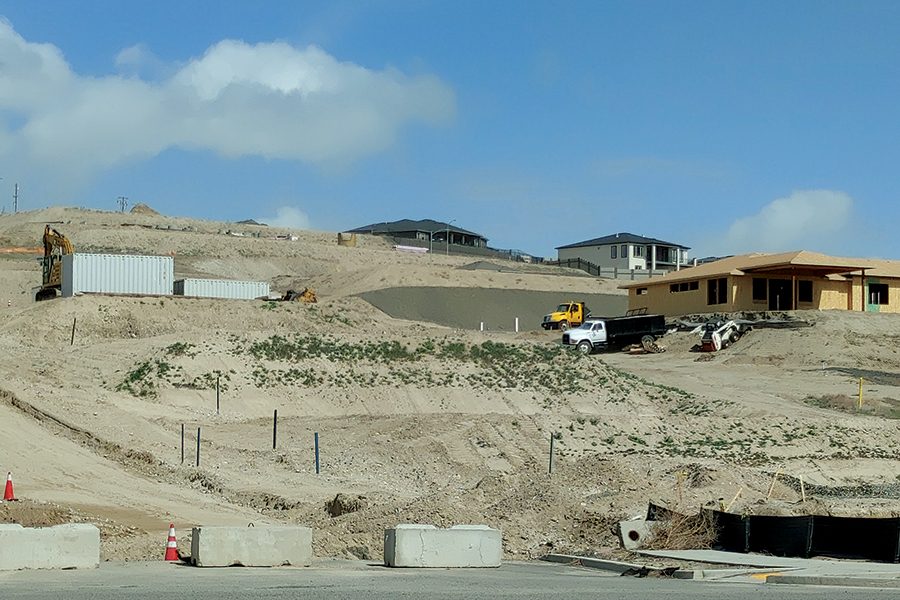
Home » GMA is aggravating housing shortage in Tri-Cities, officials say
GMA is aggravating housing shortage in Tri-Cities, officials say

April 12, 2022
A young relative asked Jeff Losey if he should wait for the housing market to cool down before purchasing his first home.
Losey, executive director of the Home Builders Association of Tri-Cities, said he advised against waiting.
“The water level is what it is,” he said, referring to current home prices. “It’s not going to precipitously go down.”
Losey, together with Ron Almberg, president of the Tri-City Association of Realtors, provided their insights into what’s driving the Tri-City housing market during a recent episode of the Tri-City Development Council’s weekly Coffee with Karl Dye program.
What is driving the market? Low interest rates, job creation and population growth. And the 1990 Washington Growth Management Act.
The Federal Reserve may be raising interest rates in a bid to control inflation, but the other factors driving down inventory and driving up demand – and prices – aren’t abating, they agreed.
Young and first-time buyers are the hardest hit, but they aren’t alone, said Almberg, a designated broker with Keller Williams Tri-Cities when he’s not leading the industry association that represents about 850 local real estate professionals.
Older residents looking to downsize into single-level homes have few choices also.
“It’s not just first-time home buyers. It’s older folks. They’re having a challenge too.”
Fewer getting built
Losey outlined how builders secured fewer permits for new homes in 2021 than the year prior, not because demand is abating but because buildable lots are scarce in some areas.
Tri-City homebuilders secured permits to construct 1,647 homes in 2021, down 1,695 from in 2020.
He blames Washington’s Growth Management Act for making it difficult to expand city limits – and services.
“The GMA is the thorn in the side of every jurisdiction. It’s more expensive because you’ve restricted the supply,” he said.
Kennewick housing starts dipped to 238 in 2021, from 290. Losey anticipates a jump in 2022 as work proceeds in the Southridge area as land is prepared along the base of Thompson Hill. A drive along Bob Olson Parkway readily affirms that land is being prepared for future subdivisions.
Pasco saw a dip too and like Kennewick, it is not for lack of demand but rather available lots. When the urban growth boundary is approved, land will be developed.
“We expect that to pick up again,” he said.
Richland and West Richland were strong performers thanks to the available lots at Badger Mountain South for the former and Aho Development’s Heights at Red Mountain Ranch in the latter.
The numbers
Almberg painted a difficult portrait of the Tri-City residential market for buyers.
The median home price in the Tri-Cities rose to $400,000 by the end of 2021, up 20% from the year prior.
The average list price for a three-bedroom home – the most common sold – was about $369,000 in 2021. Tellingly, three-bedroom homes sold for slightly more than their average asking price, about $374,000 on average.
Agents now advise buyers not to put in offers that are less than full price.
There is a positive aspect, though.
The Tri-Cities is not Seattle, Portland or even Boise, where homes sometimes draw headlines by selling for hundreds of thousands of dollars more than the list price.
Local homes may sell for four figures over asking, but not six.
“Buyers aren’t that desperate,” he said. “They won’t way overpay.”
The price range for homes is on the rise.
A decade ago, most homes sold in the $120,000-$330,000 range. Five years ago, the bottom end shifted up to $160,000. Today, the range is closer to $330,000 to $500,000-plus.
“There’s a huge change,” Almberg said.
Interest rates
With inflation approaching 8% in early April, homebuilders anticipate the Fed will take a series of steps to bring it under control.
Robert Dietz, NAHB’s chief economist, outlined his expectations in his e-newsletter, Eye on the Economy, in March.
“The economic projections provided by the (Federal Reserve) indicate that markets may expect six additional 25 basis-point increases through the end of 2022,” he wrote.
Losey warned buyers – and others – to be mindful that the cost to borrow will go up.
“Absolutely, rates are going up,” Losey said. “If you want to get that pool, you’d better do it now.”
Almberg said when the Federal Reserved approved a rate hike of 0.25 percentage points in March – its first in more than three years – it shaved $40,000 off the buying power of a typical buyer.
Affordability
According to Losey, the Tri-City housing market is increasingly unaffordable.
Only 20% of families in the community have the income to afford a median new home price of $569,000. Statewide, only 24% can.
And he notes that for every $1,000 in added cost in the Tri-Cities, another 80 families are moved out.
That matters a lot to the Tri-Cities, which has traditionally marketed itself as an affordable place to live.
Almberg said one unintended consequence is the community is building out – with people choosing to commute to Tri-City jobs from homes in Prosser, Connell and in his own case, Benton City.
Rising gas prices may dent the trend, but he said he’s noticed builders are moving further out. He said he moved to Benton City about seven years ago because he wanted new construction. But the alfalfa field next door now has 42 homes on it.
Real Estate & Construction Local News
KEYWORDS april 2022





